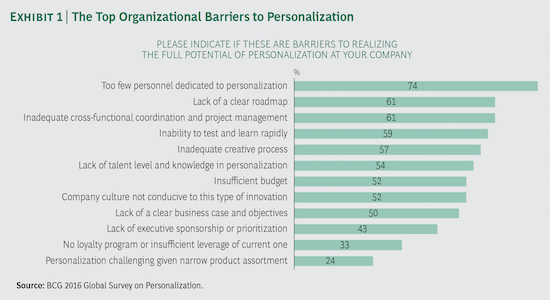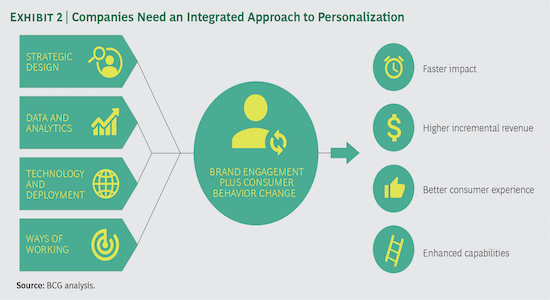
Personalization drives profits, but too few get the message
By cameron in Uncategorized
It’s too easy for “transformative” business concepts to become tired buzzwords. They do a lot of jogging from think pieces to trade shows and boardroom discussions.
Those who can see the near-term future with clarity may be frustrated by those with a generally fuzzy understanding of the benefits.
So it’s a good thing that BCG has backed-off the warm vibes promotion of personalization as a powerful strategy to improve service (though it certainly is that) and focused on the thing most likely to prick up ears in boardrooms around the globe: money, money, money.
In a paper published on the topic, BCG argues the profit potential of personalization.
“Brands that create personalized experiences by integrating advanced digital technologies and proprietary data for customers are seeing revenue increase by 6% to 10%, according to our research.
“Personalization will push a revenue shift of some $800 billion to the 15% of companies that get it right.”
The consultancy also clearly defined the hurdles companies face in deploying personalized digital strategies and the resources companies need to overcome those hurdles.
“A lack of dedicated personnel is the most-oft-cited barrier (74%), but the majority of companies also face hurdles that are organizational and cultural in nature.
“These include insufficient cross-functional coordination (61%), inadequate creative processes (57%), lack of talent and knowledge (54%), and cultures that are not conducive to innovation (52%).
“More than 60% feel that they lack a clear roadmap, and half cite the absence of a clear business case and objectives.”
[Click on image for larger version]
That a large majority of companies lack the project management coordination, clear roadmap, and personnel to effectively deploy personalized digital strategies could be attributed to that dreaded buzzword exhaustion. This big idea has been “muted”, especially at the top where active sponsorship of change is desperately needed.
“Our survey found that at half of the top performers, the CEO and the board oversee personalization programs; that is the case at only about 20% of all companies.
“Only about 15% of companies can be considered true personalization leaders, and most of them are tech companies and digital natives.
“Another 25% are experimenting with one-to-one campaigns (but only 13% say they deploy truly customer-specific individual messages, and only 7% manage fully integrated tailored communications across all channels).
“The remaining 65% are still using segmented marketing or even mass-market approaches.”

While money may be the ultimate motivator, it can also be a hurdle. Personalization can be expensive to deploy.
“Half of the survey respondents have more than 25 employees dedicated to personalization programs and are spending more than $5 million a year on personalization campaigns.”
Even at companies with large budgets walking into the Board Room to ask for $5 million a year and 25 members of staff for a venture which will upturn the company’s technology and marketing strategies is intimidating, terrifying, in some cases career-ending.
So it’s no surprise that most dip their toes in the personalization shallows and refuse to dive off the springboard by the deep end—even if that is where the treasure chest lies.
The irony is that smaller, leaner companies — with everything to loose and the will to survive — seem better equipped to embrace these strategies and convert them to profit engines.
“Digital natives have a head start because they have built their business models around collecting data and responding to customer needs.
“These companies build strong customer loyalty using both traditional vehicles, such as loyalty programs, and new models, like ‘free’ and short-notice delivery, automatic replenishment, and other forms of convenience.”
To reap a share of that $800 billion the top 15% of companies will enjoy — to incrementally improve revenue by 6% to 10% — the leap needs to come from the top down.
The C-Suite has to get past the buzzy noise and focus on the core message: personalization isn’t a want or an ask. It is a vital competitive strategy.
We’ve been hearing about personalization for a while, even from Hollywood, and we’ll keep hearing about it.
The future belongs to those travel companies which listen to the message and act.
![]()

